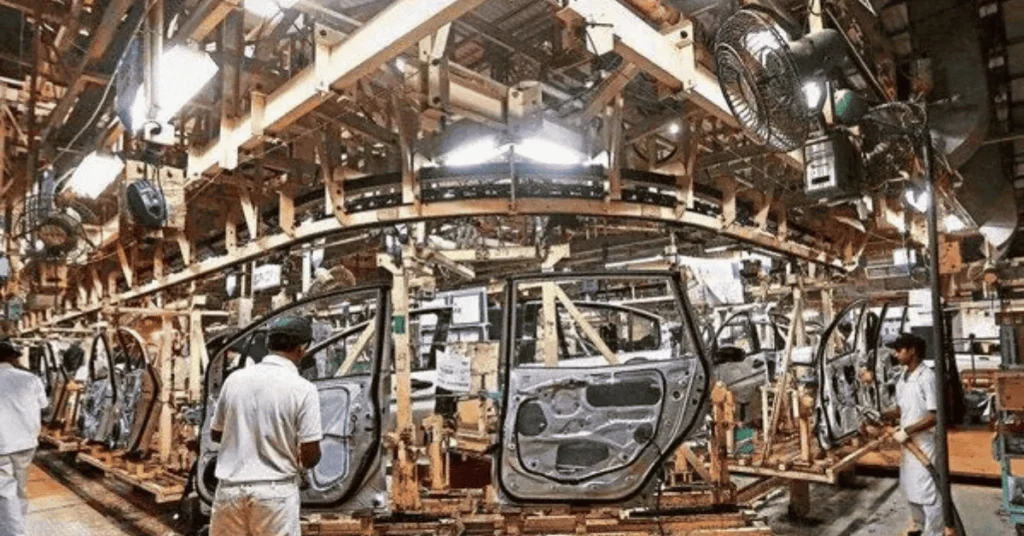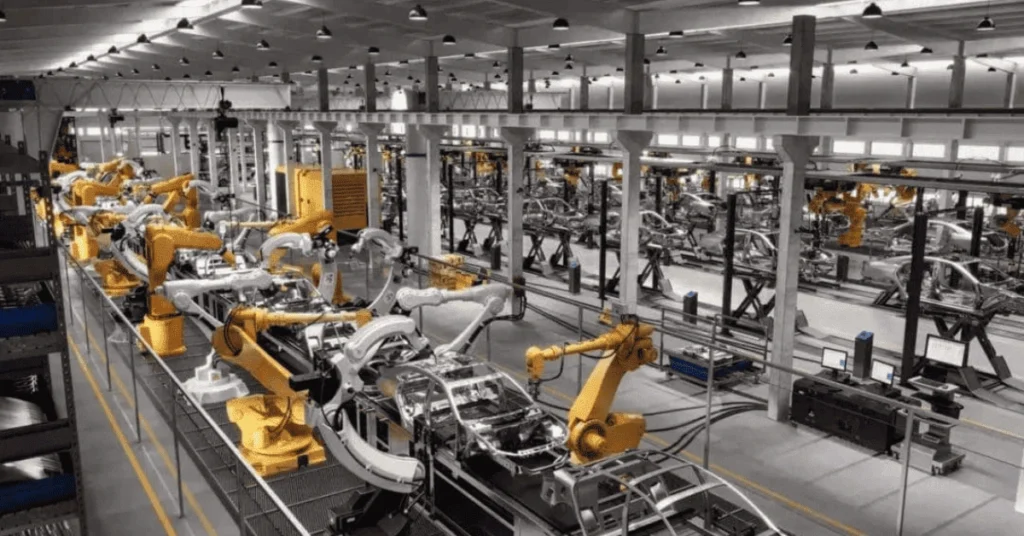Our Location
304 North Cardinal St.
Dorchester Center, MA 02124

India’s manufacturing sector has seen tremendous evolution over the past two decades. From being primarily domestic-driven and labor-intensive to now adopting automation, AI, and smart technologies, the sector has embraced change to match global standards. With the government’s vision to transform India into a $1 trillion manufacturing economy by FY26, several structural and policy reforms have been rolled out to accelerate growth.
This blog dives deep into the key drivers fueling this transformation—including robust demand, policy reforms, strategic investment, and competitive advantages—while addressing challenges and mapping the road ahead.
Manufacturing contributes nearly 17% to India’s Gross Domestic Product (GDP). It is not only a major source of employment but also plays a vital role in export performance, infrastructure development, and technological advancement. The sector’s significance becomes even more apparent when considering the goals of job creation, economic self-reliance (Atmanirbhar Bharat), and global competitiveness.
Historically dominated by textiles, steel, and basic consumer goods, the Indian manufacturing industry now includes advanced sectors such as:
In FY25 (until December 2024), India’s merchandise exports reached Rs. 27,94,695 crore (US$ 321.71 billion), surpassing the previous year’s Rs. 27,50,739 crore (US$ 316.65 billion). This steady increase demonstrates the growing reputation of Indian goods across sectors such as pharmaceuticals, engineering, textiles, and electronics.
India is projected to have the second-largest middle class in the world by 2030, contributing 17% to global consumption. This segment is driving demand for high-quality products ranging from automobiles to home appliances, wearable technology, and housing infrastructure.
Such demand pressures manufacturers to scale, innovate, and diversify, resulting in a more robust industrial base.
Domestic investment announcements surged from Rs. 10 lakh crore (US$ 115.69 billion) in FY21 to Rs. 37 lakh crore (US$ 428.04 billion) in FY23-FY24. Already, 9M FY25 has seen Rs. 32 lakh crore (US$ 370.20 billion) worth of investments. Sectors like semiconductors, battery manufacturing, drones, and medical devices have seen increased investor interest.
FDI in India’s manufacturing sector has reached Rs. 14,45,781 crore (US$ 165.1 billion), up 69% over the past decade. From FY20 to FY24, total FDI inflows were Rs. 33,58,310 crore (US$ 383.5 billion). India’s growing global stature, supported by PLI schemes and streamlined approval processes, makes it a desirable destination for global manufacturers.
Countries like Japan, the US, Germany, and South Korea are increasingly investing in Indian manufacturing capacities.
Launched in 2014, the ‘Make in India’ initiative aims to position India as a global manufacturing hub by:
The government has approved PLI schemes for 14 sectors including:
These schemes offer performance-based incentives to manufacturers, thus encouraging scalability and competitiveness.
The Drone Promotion and Utilisation Policy 2025 includes:
This policy will promote drone manufacturing, R&D, and adoption in agriculture, healthcare, logistics, and disaster management.
Investments in industrial corridors, metro systems, smart cities, and highways have significantly improved logistics and mobility. Projects like Bharatmala, Sagarmala, and the Delhi-Mumbai Industrial Corridor enhance the ecosystem for manufacturing.
High M&A activity across pharmaceuticals, EVs, and clean energy has brought in innovation and global best practices. PE/VC funding is also growing in deep-tech manufacturing, including 3D printing and nanotech.
Adoption of smart manufacturing, IoT, robotics, and cloud computing is making Indian factories more efficient and productive.
Massive investments in industrial corridors, smart cities, logistics, and digital infrastructure have made India more competitive globally. From Bharatmala highways to Dedicated Freight Corridors, logistics costs are reducing, thereby improving manufacturing efficiency.
Private equity (PE), venture capital (VC), and merger & acquisition (M&A) activity are fueling innovation and capacity expansion in:

India’s automobile sector is one of the top contributors to GDP and exports. From conventional vehicles to electric mobility solutions, manufacturers like Tata Motors, Mahindra, and Maruti Suzuki are scaling up operations with green technologies and global standards.
Electronics exports have doubled in the past five years. Companies like Foxconn, Samsung, and Apple suppliers are expanding manufacturing bases in India, driven by the PLI for electronics and semiconductors.
With the global focus on sustainability, India’s textile sector is evolving through:
Global fashion exports
Eco-friendly production
Smart fabrics
Known for policy reforms and infrastructure, Gujarat excels in chemicals, petrochemicals, and engineering goods.
Gujarat’s state-level leadership in manufacturing is the result of a well-rounded approach combining policy innovation, infrastructure development, and industrial-friendly governance. Here’s how Gujarat has become a manufacturing powerhouse in India:
Gujarat’s government has consistently introduced industry-focused policies like:
Gujarat is known for its high-quality infrastructure, such as:
Gujarat has carved niches in multiple industries:
| Factor | Impact |
|---|---|
| Industrial Policies | Attracts both MSMEs and large enterprises |
| Infrastructure | Lowers logistics cost and improves efficiency |
| Business Environment | Investor confidence and fast clearances |
| Sectoral Expertise | Competitive edge in multiple manufacturing domains |
| Global Engagement | Boosts exports and brings FDI |
| Skilled Workforce | Improves quality and productivity |
Leads in automotive and electronics manufacturing; hosts major R&D centers.
Maharashtra has established itself as a leader in India’s manufacturing sector through a combination of strategic policies, robust infrastructure development, and significant investments. Here’s how the state has achieved this:
Maharashtra’s government has implemented forward-thinking industrial policies aimed at boosting manufacturing growth. The Industrial Policy 2019, for instance, set ambitious targets.
Achieve a manufacturing sector growth rate of 12–13% annually, Increase the manufacturing sector’s share to 25% of the state’s Gross State Domestic Product (GSDP) by 2023–24. Attract investments totaling ₹10 lakh crore, These policies focus on enhancing the manufacturing ecosystem through fiscal and non-fiscal interventions, promoting ease of doing business, and encouraging sustainable and inclusive industrial growth.
The Maharashtra Industrial Development Corporation (MIDC) plays a pivotal role in providing the necessary infrastructure for industrial growth.
Industrial land and built-up space. Essential utilities like water supply, roads, and drainage facilities. Development of industrial zones across the state. MIDC’s efforts have been instrumental in creating a conducive environment for industries to thrive.
Maharashtra has attracted substantial investments in various sectors, reinforcing its manufacturing prowes:
These investments not only boost the state’s economy but also position Maharashtra as a hub for emerging industries.
The state is proactively fostering growth in new sector:
Maharashtra contributes significantly to India’s industrial output:
These figures underscore the state’s vital role in India’s manufacturing landscape.
Through strategic policymaking, infrastructure development, and attracting major investments, Maharashtra continues to solidify its position as a manufacturing leader in India.
Known for its port infrastructure and SEZs, the state supports electronics, garments, and renewable energy sectors.
Tamil Nadu has emerged as a state-level leader in manufacturing due to its robust infrastructure, investor-friendly policies, and skilled workforce. With a strong presence in sectors like automobiles, textiles, electronics, and engineering, the state offers well-developed industrial corridors, special economic zones (SEZs), and ports that boost export capabilities.
Government initiatives like the Tamil Nadu Industrial Policy and Ease of Doing Business reforms have attracted both domestic and global manufacturers, making it one of India’s most dynamic industrial hubs.
Emerging as a manufacturing hub with significant investment in defense corridors and electronics clusters.
Uttar Pradesh has emerged as a manufacturing leader in India through strong policy support, infrastructure development, and investment-friendly reforms. Key initiatives like the One District One Product (ODOP) scheme have boosted local industries, while large-scale investments in mobile manufacturing and electronics—such as Samsung’s Noida plant—have positioned the state at the forefront of industrial growth. The state is also promoting defense manufacturing through the Defence Industrial Corridor and encouraging clean tech via its EV policy. These efforts collectively strengthen UP’s role as a major industrial hub in India.
These sectors are critical for the future and are receiving targeted policy attention.

With increasing tensions between China and the West, India is positioning itself as a trusted alternate supplier for global corporations.
Companies are adopting India as a secondary base outside China for production. This trend is particularly visible in electronics, chemicals, and auto components.
The Indian government continues to set ambitious goals while private enterprise accelerates toward them.
Manufacturing industries in India are experiencing an inflection point. With a clear vision, strategic reforms, and supportive policies, the nation is rapidly transforming into a global industrial giant. From robust demand to increasing investments and sectoral leadership, all signs point toward sustainable and inclusive growth.
By 2030, not only will Indian manufacturing reach its $1 trillion goal, but it will also redefine global standards of innovation, resilience, and economic strength.

Welcome! I am a dedicated entrepreneur running an industrial affiliate product website, helping businesses and professionals find the best tools, equipment, and resources for their needs. With a passion for industrial products and a keen eye for quality, I curate and recommend top-performing items that enhance efficiency and reliability.
Through my platform, I aim to simplify the buying process by providing valuable insights, expert reviews, and trusted affiliate links to high-quality industrial products. Whether you’re looking for the latest machinery, tools, or safety gear, I strive to connect you with the best solutions available.
Thank you for visiting, and I look forward to helping you make informed purchasing decisions!